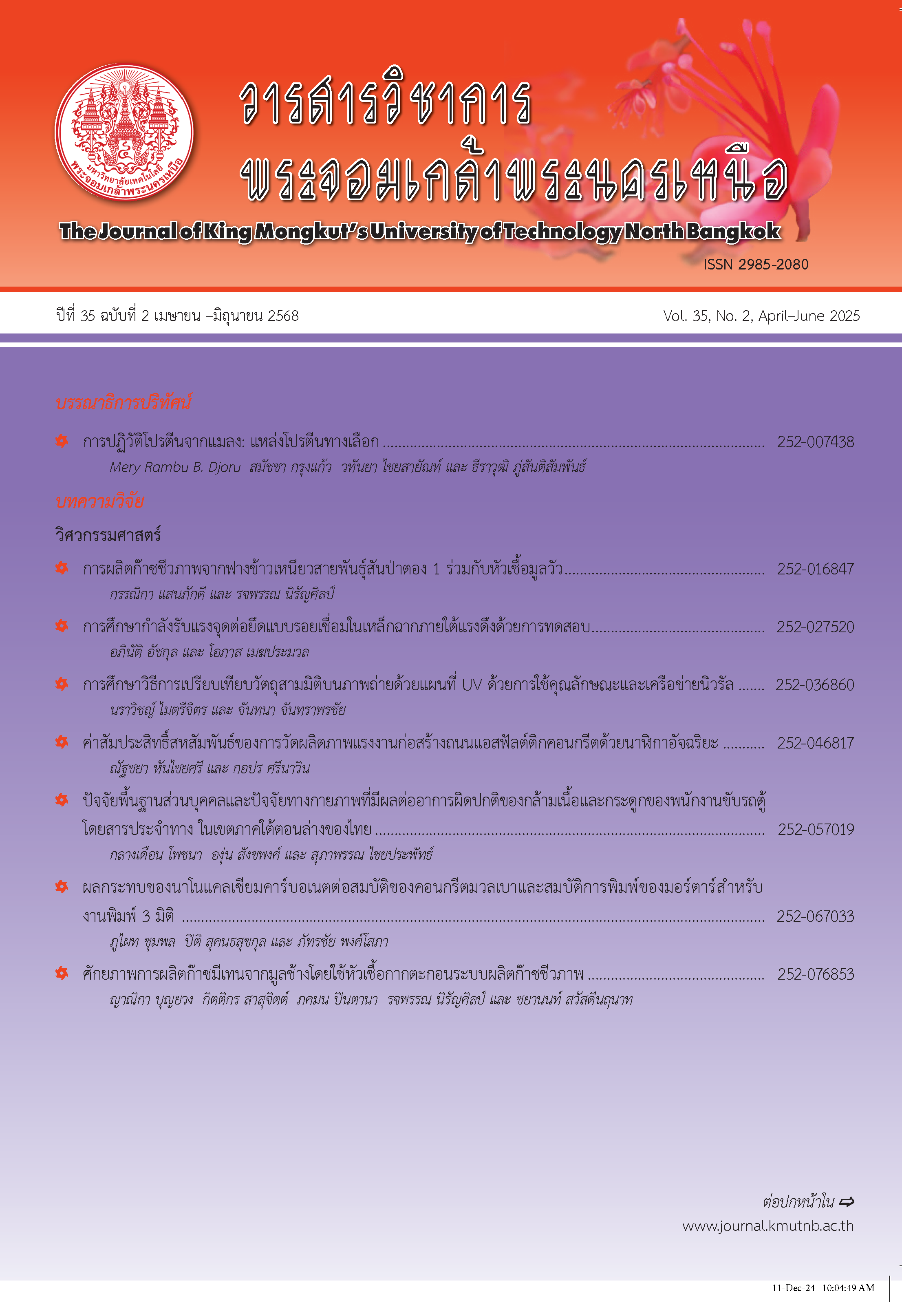การผลิตก๊าซชีวภาพจากฟางข้าวเหนียวสายพันธุ์สันป่าตอง 1 ร่วมกับหัวเชื้อมูลวัว
Main Article Content
บทคัดย่อ
งานวิจัยนี้มีวัตถุประสงค์เพื่อศึกษาการผลิตก๊าซชีวภาพจากฟางข้าวเหนียวสายพันธุ์สันป่าตอง 1 ร่วมกับมูลวัว ดำเนินการภายใต้การย่อยสลายแบบไร้ออกซิเจนที่มีการหมักแบบแบทช์และมีสภาวะอุณหภูมิเมโซฟิลิก 35±2 องศาเซลเซียส เป็นเวลา 45 วัน กำหนดอัตราส่วนระหว่างวัตถุดิบตั้งต้นและหัวเชื้อถูกควบคุมที่ 1:2 โดยน้ำหนักต่อปริมาตร ซึ่งฟางข้าวถูกปรับสภาพด้วย 4 วิธี ที่ต่างกัน ได้แก่ 1) โซเดียมไฮดรอกไซด์ร้อยละ 2 โดยน้ำหนักต่อปริมาตร 2) การหมักกรด 3) การให้ความร้อนโดยใช้เครื่องหม้อนึ่งไอน้ำแรงดันสูง และ 4) การปรับสภาพด้วยโซเดียมไฮดรอกไซด์ร้อยละ 2 โดยน้ำหนักต่อปริมาตร ร่วมกับการใช้เครื่องหม้อนึ่งไอน้ำแรงดันสูง นอกจากนี้ยังใช้ฟางข้าวที่ไม่ผ่านการปรับสภาพเป็นตัวควบคุม ผลการศึกษาพบว่า การใช้ฟางข้าวที่มีการปรับสภาพด้วยโซเดียมไฮดรอกไซด์ร้อยละ 2 โดยน้ำหนักต่อปริมาตร ร่วมกับเครื่องหม้อนึ่งไอน้ำแรงดันสูงมีประสิทธิภาพการกำจัด COD สูงที่สุดที่ร้อยละ 69.6 เมื่อเปรียบเทียบกับการปรับสภาพด้วยวิธีอื่น ซึ่งให้ปริมาณของก๊าซชีวภาพสะสมมากที่สุด 2,114.26 มิลลิลิตรต่อ 45 วัน ศักยภาพการผลิต ก๊าซมีเทนที่ 706.00 มิลลิลิตรต่อกรัมของแข็งระเหยง่าย และค่าสัดส่วนของก๊าซมีเทนร้อยละ 66.0 ดังนั้นจึงสามารถสรุปได้ว่าการใช้ฟางข้าวเหนียวสายพันธุ์สันป่าตอง 1 สามารถเป็นวัตถุดิบในการผลิตก๊าซชีวภาพได้อย่างมีประสิทธิภาพ เป็นการนำวัสดุเหลือทิ้งมาใช้ให้เกิดประโยชน์ เพิ่มมูลค่าผ่านกระบวนการผลิตพลังงานทดแทน และช่วยแก้ปัญหาการเผาไหม้วัสดุเหลือทิ้งทางการเกษตรได้อีกด้วย
Article Details

อนุญาตภายใต้เงื่อนไข Creative Commons Attribution-NonCommercial-NoDerivatives 4.0 International License.
บทความที่ลงตีพิมพ์เป็นข้อคิดเห็นของผู้เขียนเท่านั้น
ผู้เขียนจะต้องเป็นผู้รับผิดชอบต่อผลทางกฎหมายใดๆ ที่อาจเกิดขึ้นจากบทความนั้น
เอกสารอ้างอิง
R. Tunlaya, “The public participation in the control of agricultural residues burning regulation,” Thesis B.S., Natural Resources and Environment, Naresuan University, 2020 (in Thai).
M. Sutharat and B. Susira, “Health risk assessment of exposure PM2.5 from industrial area in Pluak Daeng district, Rayong province,” Naresuan Phayao Journal, vol. 14, pp. 95–110, 2021 (in Thai).
P. A Htay, “Optimizing Methanation of Cassava Pulp Digestion by Zero Valent Iron,” Degree of Doctor of Philosophy in Environmental Engineering, Suranaree University of Technology Academic, 2019 (in Thai).
P. Kittiya, S. Prapa and P. Ratchapol, “Biogas production from pretreated cattail (Typha angustifolia L.) with cow dung by Fed-batch fermentation process,” Veridian E-Journal, Science and Technology Silpakorn University, vol. 4, no. 5, pp. 2408–1248, 2017 (in Thai).
P. Supawadee, “Pretreatment of lignocellulosic materials for ethanol production,” Faculty of Science and Technology, vol. 5, pp. 641–649, 2014 (in Thai).
K. Fokion, C. Denise, D. James, G. K. Kimon- Andreas, and C. Afroditi, “Anaerobic digestion of steam-exploded wheat straw and co-digestion strategies for enhanced biogas production,” Applied Sciences, vol. 10, pp. 8284, 2020.
W. Soontornchaiboon, T. Plyngam, and R. Pawongrat, “Pretreatment of coconut husk for biogas production by anaerobic fermentation with cow dung,” RMUTP Research Journal, vol. 9, no. 2, pp. 19–30, 2015 (in Thai).
S. Sasithorn, C. Tapana, H. Nigran, C. Jutaporn, and N. Rotjapun, “The study of the mixing duration time and recirculation rate effect to biogas production from sweet corn waste by dry fermentation process,” CRMA Journal, vol. 18, 2020 (in Thai).
C. Natthaporn, “Microwave-Assisted Alkali Pretreatments Of Rice Straw For Enhancing The Efficiency Of Enzymatic Hydrolysis,”Suranaree University of Technology, 2016 (in Thai).
S. Pimnarin, R. Pichaya, and N. Chackrit, “Physical Pretreatment of Water Hyacinth for Biogas Production,”Thai Environmental Engineering Journal, vol. 30, no. 2, pp. 9-18, 2016 (in Thai).
P. Ratchapol, “Pretreatment processes for enhancing the efficiency of ethanol production from lignocellulosic agricultural wastes,” Veridian E-Journal,Science and Technology Silpakorn University, vol. 2, no. 1, pp. 2408–1248, 2015 (in Thai).
S. Michel, W. H. Stijn, H. Van, H. Sander, V. Han, and R. Katleen, “Laccase Enzyme Detoxifies Hydrolysates and Improves Biogas Production from Hemp Straw and Miscanthus, Bioresource Technology, vol. 244, no. 1, pp. 597–609, 2017.
P. Piyanut, “Study of Xylose Production from Oil Palm Empty Fruit Bunch,” M.S. thesis, Engineering in Chemical Engincering Prince of Songkla University, 2014 (in Thai).
P. Ratchapol, “The optimal condition for hydrolyses preparation from water hyacinth using autoclave for ethanol production,” Veridian E-Journal,Science and Technology Silpakorn University, vol. 4, no. 1, pp. 891–901, 2011 (in Thai).
D. Aditi, G. Tanvi, K.T. Abhilash, M. Julie, F. Kylie, and K. S. Rajesh, “Thermophilic Anaerobic Digestion: Enhanced and Sustainable Methane Production from Co-Digestion of Food and Lignocellulosic Wastes,” Energy, vol. 11, pp.1-13, 2018.
K. Chitchanoke, “Biogas production from rubber leaves by co-digestion with pig manure for household-scale,” M.S. thesis, Engineering in Chemical Engineering Prince of Songkla University, 2011 (in Thai).
P. Khathapon and R. Thaneeya, “Evaluation of biogas production potential from combination of food waste with Pre-treatment of napier grass by NaOH,” Civil Engineering, vol. 25, pp. 1–6, 2020 (in Thai).
M. Gabriele, P. Stefano, N.L. Piet, and E. Giovanni, “Increased biogas production from wheat straw by chemical pretreatments,” Renewable Energy, vol. 119, pp. 608-614, 2018.
K. Chutima, K. Kulyakorn, and Y. Supawadee, “Development of the biogas production system from a Co-digestion of inoculums chicken manure and napier grass in covered lagoon with circulating,” NIGRC KKU, pp. 445–455, 2017 (in Thai).
T. Amorpan, S. Kanyarat, Y. L. Shao, P. Chettaphong, S. Chayanon, and C. Sumate, “Anaerobic digestion of napier grass (Pennisetum purpureum) in two-phase dry digestion system versus wet digestion system,” Bioenergy Research, vol. 13, pp. 853–865, 2020.
W. Watcharapol, “Alkaline pretreatment and temperature effect in anaerobic excess sludge digestion,” M.S. thesis, Engineering in Environmental, Suranaree University of Technology, 2013 (in Thai).
N. Remli, U. Shah, R. Mohamad, and S. Abd-Aziz, “Effects of Chemical and Thermal Pretreatments on the Enzymatic Saccharification of Rice Straw for Sugars Production,” BioResources, vol. 9, no. 1, pp. 510–522, 2014.
U H. Javier, O H. Inty, M C. Mónica, S. Alexia, H. Fernando, and B. Nagamani, “Insight into pretreatment methods of lignocellulosic biomass to increase biogas yield: current state, challenges, and opportunities,” Applied Sciences, vol. 9, no. 18, pp. 3721, 2019.
A. Abraham, A K. Mathew, H. Park, O. Choi, R. Sindhu. Parameswaran, A. Pandey, J. H. Park, and B. Sanga, “Pretreatment strategies for enhanced biogas production from lignocellulosic biomass,” Bioresource Technology, vol. 301, pp. 122725, 2020.
T. Liua, X. Zhou, Z. Li, X. Wang, and J. Sun, “Effects of liquid digestate pretreatment on biogas production for anaerobic digestion of wheat straw,” Bioresource Technology, vol. 280, pp. 345–351, 2019.
C. Nilwan, M. RomSai, C. Warut, and W. Anuphan, “The potential of methane production of the dwarf napier under alkaline pretreatment,” RMUTL Engineering Journal, vol. 1, pp. 32–36, 2016 (in Thai).
L. Kamoldala, D. Natthawut, and D. Chonlada, “Study of biogas production from agricultural waste to decrease the pollution in northern region,” ITTECON, vol. 3, pp. 1–9, 2015 (in Thai).

